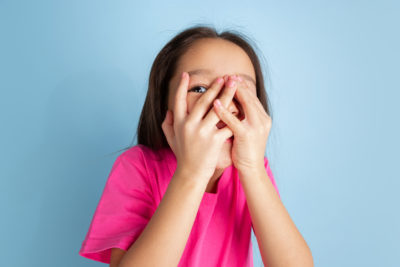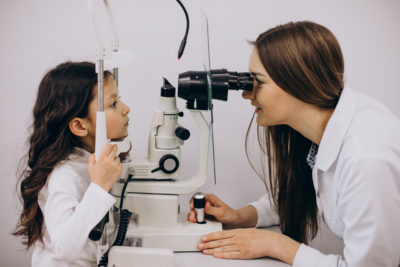Many years ago Von Graefe, a famous ophthalmologist defined lazy eye as a condition in which the observer sees nothing and the patient very little. This sums it all. A child with lazy eye may not even realize that the abnormal eye sees so little and the observers around the child be it the parent or teacher does not notice this as the child continues to do all the work with the normal functioning other eye. So a child needs a routine evaluation as early as possible in life. This is where school vision screening plays a wonderful role and picks up those unwary cases of lazy eye.
What are the causes of lazy eye in a child?
There are so many children around us with a deviation or misalignment of eyes. Parents consider this as an insignificant issue, thinking it to be only a cosmetic blemish. Seldom do they realize that this eye with the squint could also be having poor vision.
Children could be having a large refractive error or “power” in only one eye. This prevents that eye to be used unless corrected, therefore causing lazy eye.
Sometimes both eyes can have a large refractive error like plus power or cylindrical power preventing both eyes from functioning optimally causing both eyes to become lazy.
The quality of vision could be degraded in one or both eyes due to conditions like a birth cataract, lid drooping, opacities in the clear transparent portion of the eye called cornea or bleeding inside the back portion of the eye termed medically as vitreous hemorrhage. If this continues for an unnoticed period in a child’s life, it can lead to a profound lazy eye.
Is there a remedy for this condition?
Of course the answer is a YES! The earlier it is addressed better is the prognosis or outcome. Parents need to have their child evaluated at 3.5 years of age especially where school screening is not in place. Parents cannot wait until the child starts to complain of poor vision or until they begin to notice signs that indicate vision abnormality in a child. It may be too late for the child to be addressed! Lazy eye is best addressed in the FIRST DECADE OF LIFE.
Strategies in treatment
It is a twofold strategy as far as lazy eye is concerned.
The first strategy is to clear the vision in the lazy eye. This is done by correcting refractive errors through appropriate spectacle correction in one or both eyes as the need may be. Sometimes child may need a surgery to clear the vision if there is a cataract, drooping of lid or corneal opacities.
The second strategy is to make the child use the lazy eye. This can be done by preventing the good eye from functioning.
Strategy used for stimulating the lazy eye
- Occlusion by patching – The good eye can be prevented from being used by simply closing it by means of an occluder. Commercially available hypoallergenic skin patches or spectacle patches can be used as preferred. Patching has its disadvantages as it is a cosmetic blemish, causes social stigma and children cannot comprehend why the good eye is being addressed and they are also adept in finding ways to beat the system.
- Penalization by drops – The good eye can be blurred by using drops that prevent focusing of the eye. These drops may not be as effective as patching and sometimes a switch over of fixation to the lazy eye does not happen as desired.
- Gaming Options – Binocular i -Pad games using polarizing glasses are available where both eyes are kept open during treatment and a higher contrast , brighter image is shown to the lazy eye so that it participates more in the play thereby selectively getting stimulated.
- Computerized Vision Therapy – A lot of soft wares are now available that can be installed in the system. These are again binocular treatment options where occlusion of one eye is not needed and child plays a series of games wearing red /green goggles to preferentially stimulate the lazy eye.
- Oral Drugs – Drugs can be given orally in older children in adjunct to occlusion treatment.
Is there an age limit to treat lazy eye?
There is no doubt that treatment in the first decade of life gives the best results as this is a stage in life when the visual system is best molded. But treatment can be tried even up to mid adulthood as now research has showed that certain treatment methodologies using array stimuli can cause neuromodulation even in older ages.
Lazy eye is a major public health problem. It affects 1-5 % of the childhood population and the effects last for a life time. It requires commitment and care from parents, treating eye doctors and society to achieve the best possible results. The treatment may become unpleasant for some children and it may become a burden to parents too. But it cannot stop as this is a remediable condition which can be turned around. So everyone needs to keep an eye on lazy eye for good compliance and optimum results!










